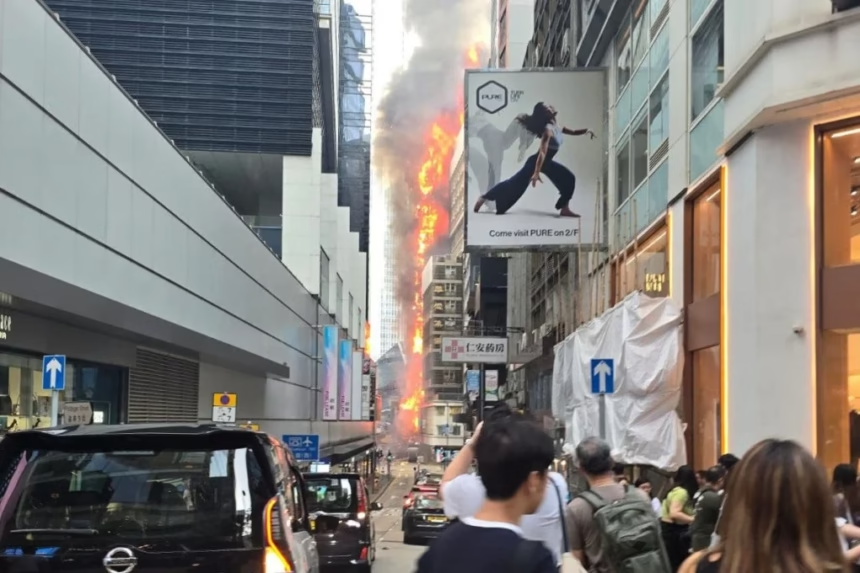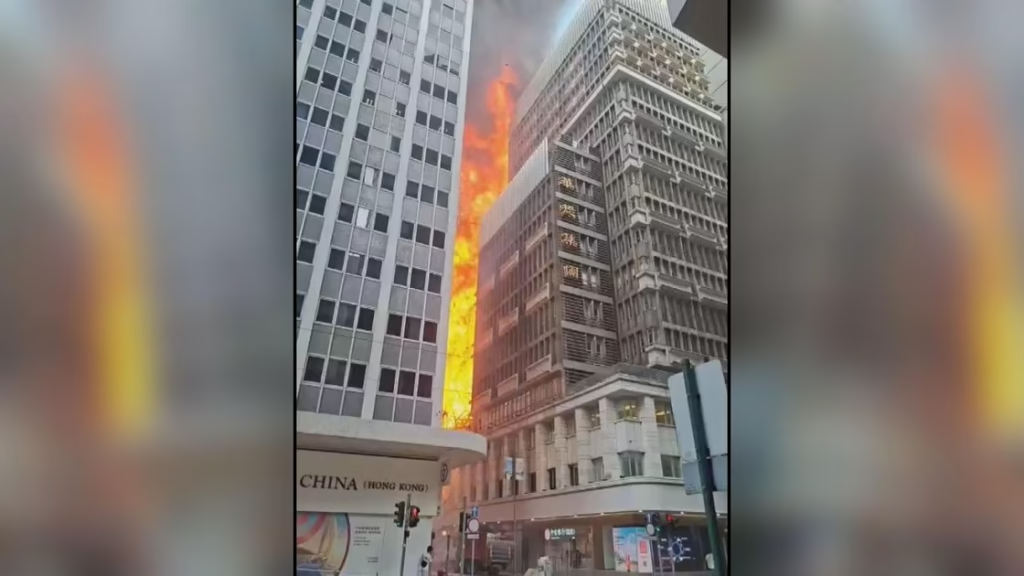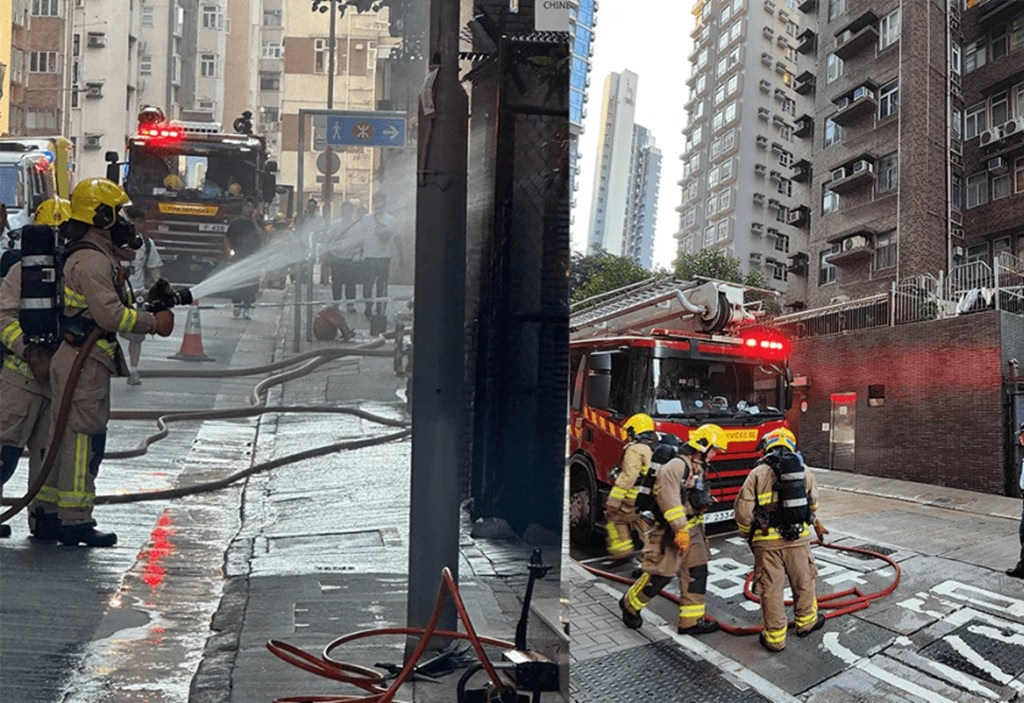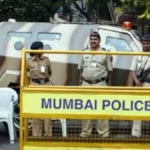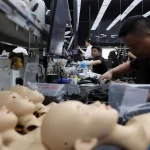HONG KONG -Afternoon turned tense in Central Hong Kong City as thick black smoke covered the sky above Chinachem Tower. A fierce blaze ripped through bamboo scaffolding at the back of the landmark office block, starting at about 4:24 p.m. on 18 October.
The incident quickly escalated to a No. 3 alarm, drawing hundreds of firefighters to a four-hour fight. Four people were taken to the hospital, and many more ran for safety. In a city proud of its speed and order, the chaos raised fresh concerns about site safety in one of the world’s most crowded districts.
Chinachem Tower, a 37-storey office building at 34-37 Connaught Road Central, is home to law firms, finance groups, and shops. Repair work on the façade had covered the rear lane in bamboo scaffolding, where the fire began.
Witnesses told SCMP that they first noticed a small spark, possibly from welding or an electrical fault, in the humid afternoon. Within minutes, flames shot upward, catching the dry bamboo and dropping burning fragments onto the street.
“I was buying a coffee two blocks away when I heard crackling,” said Li Wei, 28, who works nearby. “Then this sheet of orange fire climbed the building. People screamed, the smoke rolled in like a black fog. I could taste ash.” Posts online told similar stories, showing office staff in suits running down fire stairs, tourists stuck in shock, and MTR passengers flooding pavements as sirens echoed.
Fast-Moving Flames, Rapid Response
The Fire Services Department took the first call at 4:24 p.m., reporting smoke in the alley off Pottinger Street. Twelve minutes later, the case was raised to a No. 3 alarm, a sign the fire was too intense for a routine response. By 4:36 p.m., 36 fire engines, 15 ambulances, and 184 personnel had reached the site, turning Connaught Road into a corridor of lights and spray.
Clips on X showed the heat buckling scaffolding, which then collapsed in sparks that set a refuse skip alight and scorched a passing lorry. “It sounded like fireworks, pop, pop, pop,” wrote @HKFinGuy88, whose video drew thousands of views. Drones circled overhead to feed live images to commanders. Teams with breathing gear moved up the sides of the tower, fighting strong updrafts that drove flames up to 20 storeys high.
The fire spread so fast because of the bamboo, widely used in Hong Kong for its low cost and flexibility. Specialists later suggested welding might have ignited dry debris, although the FSD has not confirmed the trigger. “Bamboo burns hot and fast,” said Dr Mei Ling Chan, a structural engineer at the University of Hong Kong. “In a tall vertical setup, it draws air like a chimney. With stronger wind, it might have jumped to neighbouring blocks.”
Police closed roads across Central, with traffic backing up from Admiralty to Sheung Wan. The MTR paused services at Central Station. Officers pushed pedestrians back by several blocks. Faces were streaked with soot as people tried to get clear.
One viral post from @CentralChaosHK read, “Central looks empty now, no taxis, no trams, only smoke and sirens. Hoping everyone makes it out.”
Hong Kong Rescues Under Pressure
As crews fought the flames, the human impact became clear. Three men, thought to be maintenance staff, were trapped in a broken lift on the lower floors. Nearby, a family with a young child and several shop workers sheltered inside a ground-floor convenience store as smoke seeped under the door. “We heard the roof creak,” said assistant Wong Mei, 42, who held a fire extinguisher until help arrived. “The child was coughing and crying. I thought it might be the end.”
Using four water jets and cooling teams, firefighters forced open the lift at about 5:15 p.m. The men were pulled out conscious but struggling to breathe. The group in the shop was led out minutes later through a rear exit.
In total, 58 people were evacuated from the tower and nearby buildings. Paramedics treated many for smoke inhalation at the scene. Four people were sent to Queen Mary Hospital: two men in intensive care with severe breathing problems, a woman with minor burns, and another man under observation. A fifth person chose private treatment.
Assistant Divisional Officer Raymond Cheung praised crews on the ground. “These are our people in there, office workers ending their day, families shopping. We do not stop until everyone is found.” By 8:30 p.m., the fire was out. Teams stayed on site into the night with thermal cameras to check for hotspots.
Safety Questions for a City of Towers
The Chinachem Tower fire sits within a broader pattern. Hong Kong, with more than 9,000 high-rises, has recorded a rise in scaffolding-related fires, including 15 major cases in the last two years, according to FSD figures. Critics blame weak oversight and cost pressure that keep bamboo in use instead of fire-retardant options. “We are building higher and faster, but safety trails behind,” said opposition lawmaker Claudia Mo, who called for an urgent review in LegCo. “Central is the financial core; any failure hits more than property, it hits confidence.”
Chinachem Group issued a short statement on Saturday night. “We are cooperating fully with authorities and prioritising tenant support.” Some evacuees, however, spoke of earlier complaints about loose netting and unsecured poles during the works. As dawn arrived on 19 October, crews swept charred bamboo and ash from Pottinger Street, a stark sight beside polished shopfronts.
Hong Kong now takes stock. Li Wei, the marketing worker, put it plainly over breakfast. “We chase the next deal and the next deadline. Yesterday stopped us. It makes you think about what might happen next in this concrete maze.” The city moves on, grateful the injuries were limited, and alert to the risks that can flare without warning.




